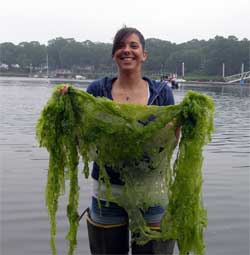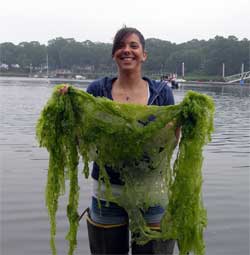 West Warwick resident evaluates impact of snails on seaweed
West Warwick resident evaluates impact of snails on seaweed
KINGSTON, R.I. – January 4, 2010 – While seaweed is considered little more than an annoyance to most people, University of Rhode Island senior Emily Vincent believes that it may be the key to her future.
The West Warwick resident and Hope Valley native spent the last six months conducting a research project on the impact of snails on populations of seaweed (also called algae) in Greenwich Bay, and as a result she is convinced that her future career will in some way revolve around seaweed.
“I learned so much through this project,” Vincent said enthusiastically. “I had known that algae was something I was really interested in from a course I had last year. But over the summer I learned that this is something I really want to continue studying in grad school. I’ve really grown to love it.
“I never knew how complex algae is,” she continued. “It was so interesting to learn about the different life cycles, and its cell structure is really interesting, too. At first you think it’s so plain and simple, and it turns out there’s so much more to it.”
Vincent grew up spending time on Rhode Island beaches, digging in the sand in search of marine creatures. As a result, she said she has always been passionate about a career in marine biology.
For her research project, sponsored by the URI Coastal Fellows program, she sought to learn whether common mud snails, which graze on seaweed in the genus Ulva, keep the seaweed under control or whether the snail facilitates its growth. Almost every day she visited beaches around Greenwich Bay and collected seaweed, some of which was taller than she is, and placed it in large tanks at URI’s Graduate School of Oceanography, where she conducted feeding trials.
“Macroalgae blooms are bad for coastal communities, causing fish kills and harming ecosystems and recreational uses of the coastline,” Vincent said. “Herbivores like snails can exert top-down control of the blooms, but we wanted to know which species they prefer to eat.”
Her initial study had surprising results. After conducting feeding trials in collaboration with URI Associate Professor Carol Thornber and graduate student Michele Guidone, she found that the snails didn’t eat the Ulva at all. Instead, they grazed on the microscopic diatoms sitting atop the blades of the seaweed. Then she ground up two varieties of Ulva and made what she called “food strips” and offered it to the snails, which quickly ate it.
Next she offered the snails a choice of food strips consisting of Ulva or diatoms, and again she got a surprise. The snails appeared to prefer one variety of Ulva over the other.
“Some algal species have chemical defenses to prevent herbivory, and that’s what we think is the case with the Ulva that the snails avoided,” Vincent said. “We think that the snails feed primarily on the detritus that falls from the algae, since they don’t appear to be eating the blades.
“We still have a lot more questions, but what we found was certainly not what we expected,” she said.
She also didn’t expect to enjoy the project so much. She hopes to continue the study next summer before enrolling in graduate school.
“I’ll probably take a year off to get more lab experience first, but ultimately I’d like to stay in academia and become a professor somewhere,” Vincent said. “I’d love to travel to learn about algae elsewhere around the world, but I’ll probably settle back here on the East Coast.”

